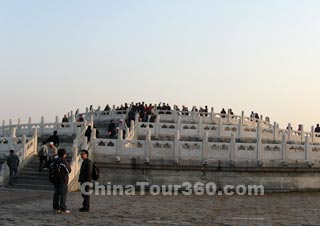 |
| Circular Mound Altar |
The Circular Mound Altar in Beijing's Temple of Heaven was built by Emperor Jiajing of the Mind Dynasty (1364 - 1644) in 1530. It was expanded by Emperor Qianlong of the Qing Dynasty (1644 - 1911) in 1749. The altar was the site of the emperors' sacrificial ceremonies to the heaven during the Winter Solstice.
The Circular Mound Altar is an open-air platform covered with blue tiles. It consists of three marble terrace, each one edged with a balustrade. The lower terrace represents Hell, the middle terrace the living world and the top terrace signifies Heaven. The number of stone components used for the altar's base, steps and railings are all 'nine' or multiples thereof since the number 'nine' was symbolic of the supreme sovereignty of heaven and the emperor. The round stone slab in the center of the altar was named 'Heavenly Center Stone. 'It's said that if one cries or produces a knocking or tapping sound when standing on the stone floor, echoes will be heard all around creating the effect of many responses to a single call.
Originally, there were three lantern poles used for producing light during a sacrificial ceremony. Now only one exists standing in the southwest corner of the altar. The pole is 28.8 meters (94.5 feet) high with a pulley on top for lifting the lanterns up and down. The light pole was also used to indication the location of and the beginning and ending of the ceremony.
A green-tiled oven called the "Firewood Stove' sits in the southeast corner of the altar. It is 2.85 meters (9.4 feet) high with an outside diameter of 3.43 meters (11.3 feet). On its east, west and south sides nine steps were built for access and egress. An opening for stoking the fire was located on the north side. Here there is also a series of hollow iron stoves used to burn pine and cypress branches for illumination.
Finally, to the east of the Firewood Stove there is a small round pit that apparently was used for burying the feathers and blood of the sacrificial animals.
Each winter solstice in the Ming and Qing Dynasties, the emperor would go to worship the heaven at the Circular Mound Altar. Before the ceremony, the emperor moved to the Hall of Abstinence and abstained from meat or wine for three days. The ceremony began at around 4:15 in the early morning before sunrise. The emperor would also put on the special celeste costume for the sacrifice ceremony.
![]() Go to the Next Attraction: Architectural Complex of Circular Mound Altar
Go to the Next Attraction: Architectural Complex of Circular Mound Altar








